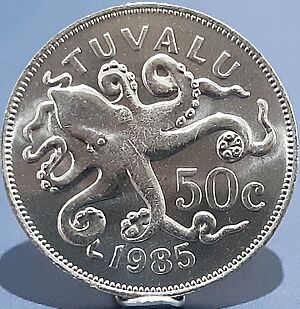Tuvaluan dollar facts for kids
Quick facts for kids Tuvaluan dollar |
|
|---|---|
| ISO 4217 Code | None |
| User(s) | |
| Inflation | 3.30% |
| Pegged with | Australian dollar at par |
| Symbol | $, $T, TV$ |
| cent | ¢ |
| Coins | ¢5, ¢10, ¢20, ¢50, $1 |
| Banknotes | Australian dollar notes circulate |
The Tuvaluan dollar is the money used in Tuvalu, a small island nation. It has an unofficial code called TVD. Tuvalu has made its own coins since 1976. However, it has never printed its own paper money.
The Tuvaluan dollar is linked to the Australian dollar. This means one Tuvaluan dollar is always worth one Australian dollar. Both currencies are used in Tuvalu. Before 1976, Tuvalu only used the Australian dollar. Tuvaluan coins are not accepted as money in Australia. The Tuvaluan dollar is like a special version of the Australian dollar, not a fully separate currency.
Tuvalu does not have a central bank. A central bank usually manages a country's money. Instead, the National Bank of Tuvalu helps the government with some money tasks. This includes holding government money and foreign funds.
In the past, other types of money were used in Tuvalu. These included the British pound sterling and the US dollar during World War II. Banknotes from the Gilbert and Ellice Islands were also used. These were like special checks, not official money.
Tuvaluan Coins: What They Look Like
Tuvalu started making its own coins in 1976. This was around the time it was becoming independent. The first coins were in values of 1, 2, 5, 10, 20, 50 cents, and 1 dollar. A designer named John Donald created them. The coins all have a theme about the ocean.
The 1 and 2 cent coins were made of bronze. The 5, 10, and 20 cent coins were made of cupro-nickel. These coins were the same size and weight as Australian coins of the same value.
The 50 cent coin was round and made of cupro-nickel. This was different from the twelve-sided Australian 50 cent coin. The 1 dollar coin was very special. It had nine sides! This was unusual for coins at the time. It also came out eight years before Australia made its own 1 dollar coin. The nine sides of the dollar coin stand for the nine islands and atolls that make up Tuvalu.
Each coin shows a sea animal from the area. The only exception is the 1 cent coin, which shows an empty spider conch shell on the beach.
In 1976, Tuvalu also made special silver and gold coins for collectors. These were a 5 dollar silver coin and a 50 dollar gold coin. They are official money in Tuvalu, but people don't use them every day.
Australia stopped using its 1 and 2 cent coins in 1991. But Tuvalu kept using them for a while. However, because prices and shipping costs went up, these small coins are now also out of use.
Australia introduced a $2 coin in 1988. Tuvalu never made its own $2 coins. Instead, people in Tuvalu use the Australian $2 coin. In recent years, people in Tuvalu also prefer Australia's smaller, round dollar coin. So, you might see Tuvalu's large, nine-sided dollar coins less often.
In 1994, the picture of the Queen on the coins changed. This happened in many Commonwealth countries. Older coins from 1976-1985 show an earlier design of the Queen. The 1994 coins were made in very small numbers. This makes them valuable to coin collectors today.
After 1994, Tuvalu stopped making its own coins. Australian coins were sent instead. However, Tuvaluan coins are still legal money. They are used alongside Australian coins.
Tuvalu also makes many special coins for collectors. These are not for everyday use. The Perth Mint in Australia makes these coins. The government of Tuvalu gets money from these special coins. They receive at least $200,000 each year in royalties.
Queen Elizabeth II was on all Tuvalu coins until 2024. Then, a picture of King Charles III was approved for some new collector coins. Some politicians wanted to remove the King's picture from future coins. But most people voted to keep the monarchy.
Here is what is shown on each coin:
| Value | Diameter | Composition | 1976–1994 | |
|---|---|---|---|---|
| Front (Obverse) | Back (Reverse) | |||
| 1 cent | 18 mm | Bronze | Queen | Spider conch shell |
| 2 cents | 21 mm | Queen | Stingray | |
| 5 cents | 19 mm | Cupronickel | Queen | Tiger Shark |
| 10 cents | 24 mm | Queen | Red eyed crab | |
| 20 cents | 29 mm | Queen | Flying Fish | |
| 50 cents | 32 mm | Queen | Octopus | |
| 1 dollar | 30–35 mm | Queen | Sea Turtle | |
Paper Money in Tuvalu
In 1942, the government of the Gilbert and Ellice Islands printed local paper money. These were in values of 1, 2, 5, and 10 shillings, and £1. They were worth the same as the Australian pound.
Since 1966, the official paper money in Tuvalu has been the Australian dollar. Australian banknotes were used before and after Tuvalu became independent. At first, only $1, $2, and $10 notes were sent to Tuvalu. But now, $5 and higher values are also used. After independence, the $1 note was taken out of use. This was to encourage people to use the $1 coin instead.
See also
 In Spanish: Dólar tuvaluano para niños
In Spanish: Dólar tuvaluano para niños




